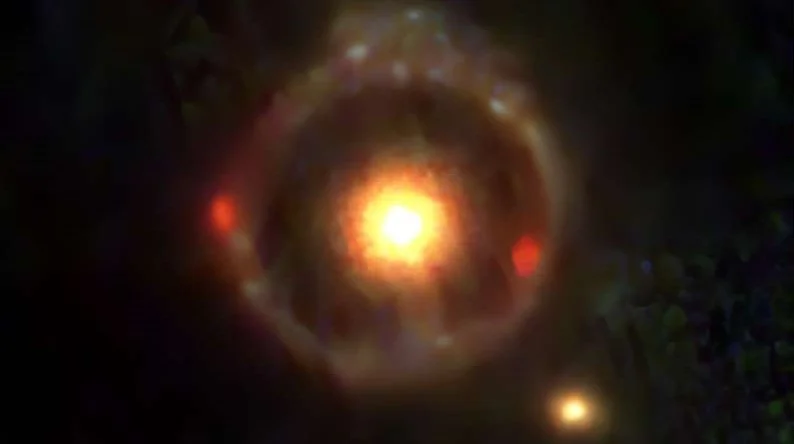JWST telescope shows an imploding galaxy in the early universe
- October 11, 2024
- 0
Using the James Webb Space Telescope, astronomers have observed for the first time a galaxy growing from the inside out in the early universe, just 700 million years
Using the James Webb Space Telescope, astronomers have observed for the first time a galaxy growing from the inside out in the early universe, just 700 million years

Using the James Webb Space Telescope, astronomers have observed for the first time a galaxy growing from the inside out in the early universe, just 700 million years after the Big Bang. Much smaller but more mature than expected, this galaxy exhibits unique growth patterns with its dense core and rapidly star-forming surroundings.
Astronomers used the NASA/ESA James Webb Space Telescope (JWST) to observe galaxy growth from the “inside out” in the early universe, just 700 million years after the Big Bang.
This galaxy is a hundred times smaller than the Milky Way, but is surprisingly mature for such an early development of the universe. Like a large city, this galaxy has a dense core of stars, but it becomes sparser in the galactic “suburbs”. And just like a big city, this galaxy begins to expand, accelerating star formation on its outskirts.
This is the earliest detection of inside-out galaxy growth in history. Before Webb, it was not possible to study the growth of galaxies at such an early stage in the history of the universe. While the Webb images are a snapshot in time, researchers led by the University of Cambridge say studying galaxies like these can help us understand how they evolved from clouds of gas into the complex structures we see today. The results were reported today (October 11) in the journal. Nature Astronomy .

One of the authors of the study, Dr. from the Cavendish Laboratory in Cambridge. “The question of how galaxies evolve over cosmic time is an important question in astrophysics,” said Sandro Tacchella. “We’ve had a lot of great data on the last tens of millions of years and galaxies in our corner of the universe, but now with Webb we can get observations going back billions of years in time, exploring the first billion years of cosmic history, which raises all kinds of new questions.”
The galaxies we see today grow by two main mechanisms: they either draw in or accumulate gas to form new stars, or they grow by merging with smaller galaxies. Together with Webb, astronomers hope to solve the question of whether different mechanisms were at work in the early universe.
“You would expect galaxies to be small to begin with because gas clouds collapse under their own gravity to form very dense stellar cores and possibly black holes,” Tachella said. “As the galaxy grows and star formation increases, it’s like a figure skater spinning: As the figure skater pulls their arms, they accelerate and spin faster and faster. Galaxies are similar in a way: Gas accumulating at increasingly greater distances then spins the galaxy upward, so they often have a spiral or disk shape.”

Observed as part of the JADES (JWST Advanced Extragalactic Survey) collaboration, this galaxy was actively forming stars in the early universe. Despite its relatively young age, it has a very dense core, about the same density as today’s massive elliptical galaxies with 1000 times more stars. Most star formation occurs further away from the nucleus, and the star formation “cluster” is even further away.
As star formation spreads and the size of the galaxy increases, star formation activity increases strongly towards the outer regions. This type of growth had been predicted by theoretical models, but with Webb’s help it can now be observed.
“One of the many reasons why the Webb is so transformative for us as astronomers is that we can now observe things that were previously predicted by simulations,” said co-author William Baker, a PhD student at Cavendish University. “This is like an opportunity to check homework.”
Using Webb, the researchers extracted information from the light emitted by the galaxy at different wavelengths and then used these to estimate the number of younger stars compared to older stars; This turned into an estimate of stellar mass and star formation rate.
Because the galaxy is so compact, individual images of the galaxy have been “modeled” to account for instrumental effects. Using stellar population modeling, which includes instructions for gas emission and dust absorption, the researchers found that while older stars are found in the core, the surrounding disk component is undergoing very active star formation. This galaxy doubles the mass of stars in its outskirts about every 10 million years, which is very fast: the Milky Way galaxy only doubles its mass every 10 billion years.
The high star formation rate, as well as the density of the galactic core, suggest that this young galaxy is rich in the gas needed to form new stars and may reflect different conditions in the early universe.
“Of course, it’s just one galaxy, so we need to know what other galaxies were doing at the time,” Tacella said. “Were all galaxies like this? We are now analyzing similar data from other galaxies. “By looking at different galaxies throughout cosmic time, we can reconstruct the growth cycle and show how galaxies grew to their final size today.”
Source: Port Altele
As an experienced journalist and author, Mary has been reporting on the latest news and trends for over 5 years. With a passion for uncovering the stories behind the headlines, Mary has earned a reputation as a trusted voice in the world of journalism. Her writing style is insightful, engaging and thought-provoking, as she takes a deep dive into the most pressing issues of our time.